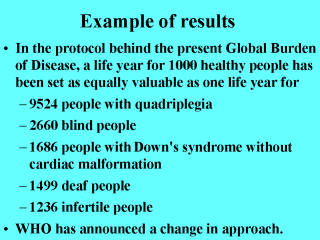 |
The PTO1
questions regards which number of disabled people is required for a life extension of 1
year for this group to be equally valuable as for a group of healthy people. The higher
the number of disabled people "on the balance", the higher the disability weight
of this diagnostic group. From the current, published, disability weights, we can
calculate the mean answer of the panel participants to this question as shown above. A
valuation of human beings according to their functional capacity is in contrast to the
humanistic values laid down in the Declaration of Human Rights: "recognition of the
inherent dignity and of the equal and inalienable rights of all members of the human
family is the foundation."19 The WHO department responsible for the global burden of
disease project aims at "strengthening the scientific and ethical foundations of
health policies.... The aim of the work is to promote equity, quality, and efficiency."(ref)
The current DALY protocol does not seem to accord with this. (Arnesen and Nord, 1999) . |
